Brief

Prepare to see America’s grocery landscape change before your eyes. The same hard discount grocers that have shaken up Europe are accelerating their growth in the US, giving shoppers even more choice and creating new competition for traditional supermarkets and mass retailers. German discounter Aldi, which now operates 1,600 stores in the US, already has plans to open about 400 more stores by the end of 2018, while simultaneously embarking on a $1.6 billion remodeling effort to give existing stores a more upscale look. And we’re in the early days of Lidl’s big launch into the US market, which is likely to add as many as 500 locations in the next five years.
All told, we expect the deep discount segment in the US to grow by 8% to 10% annually through 2020—that’s five times the rate of traditional grocers. This torrid pace of growth is fueled by discounter store economics that quickly generate cash to reinvest into both store expansion and remodeling programs that attract new customers.
While this could be great news for consumers looking for lower prices, it will become a huge challenge for incumbent grocers. A recent Bain & Company study of nearly 2,800 US shoppers at traditional grocers such as Kroger and Safeway, mass retailers such as Walmart and Target, and club stores such as Costco and Sam’s Club helps show how the grocery landscape has changed. Not only do incumbents need to be on the forefront of this change, but they also need to break down four long-held myths, or risk being ill-equipped to compete and win against hard discounters in this increasingly competitive environment.
Myth: Hard discounters cater primarily to low-income shoppers. They’re not representative of my shoppers.
Reality: According to our findings, Aldi shoppers are not too different from traditional grocery shoppers in income and education. Historically, Aldi’s strongest segments have been smaller households that are not fussy about brands. However, over the last few years, the discounter has pursued more affluent, suburban shoppers—those who typically shop at mass retailers and club stores. In particular, Aldi has increased its penetration in two specific segments that together account for about 25% of all grocery spending: Mainstreamers, classic, low-maintenance shoppers whose major preference is for stores that are clean and organized; and family focused, private-label fans who actively seek deals, scan weekly ads and shop at the lowest-priced grocery stores (see Figure 1).
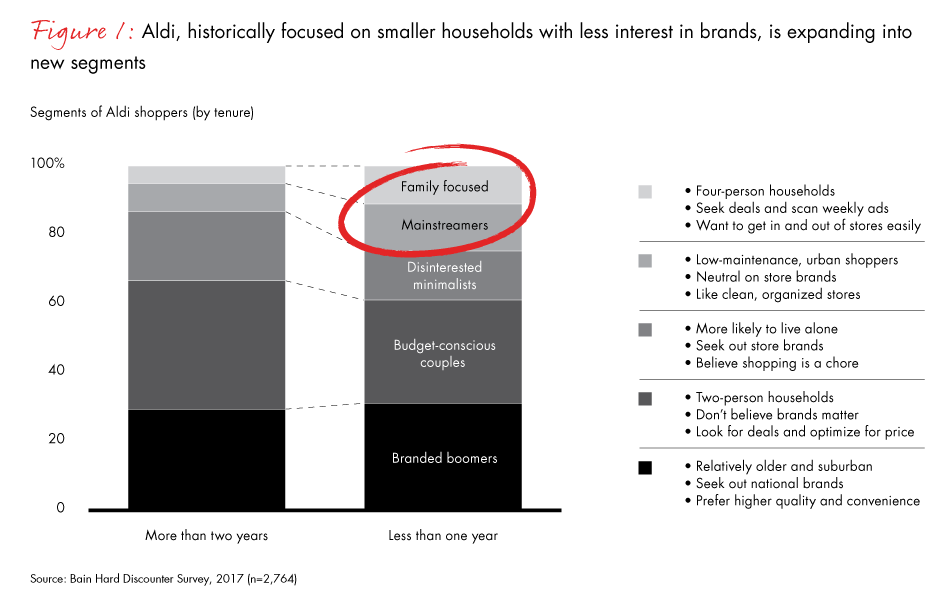
Aldi is targeting upscale areas for new store locations, remodeling stores for a sleeker feel, offering more organic and premium foods, increasing its assortment into nonfood categories such as baby products and selectively adding even more national brands. It is partnering with health and fitness social media influencers, highlighting healthy-living brands in its stores and engaging new shopper segments directly on social media. As it makes these moves, more and more middle- and upper-income and college-educated shoppers are warming to Aldi.
Meanwhile, as Lidl adds locations in the US, it plans to replace its pure discount image with modern stores that feature fresh produce, bakery and floral departments, and locally sourced products, such as wine, craft beer and coffee—items not typically associated with hard discounters. Lidl will offer more national brands than Aldi, but the foundation of its assortment will still be private brands at hard discount prices, making Lidl a compelling draw for many shoppers.
Myth: Even if they resemble hard discount shoppers, my own shoppers won’t try hard discounters because they love shopping my store.
Reality: Our findings suggest a different story. On average, 61% of shoppers who have never shopped at an Aldi before say they would likely try the discounter if one opened nearby; just above 71% said they would likely try a Lidl. (In both cases, respondents who were unfamiliar with the stores were shown photos and descriptions of the store concepts.) The main reasons they haven’t tried hard discounters yet are merely unawareness and lack of presence. This should worry grocers in the markets where Aldi—and soon Lidl—are making big expansion plans: across the Northeast, Southeast, Midwest, Texas and California. Other reasons shoppers have stayed away include assortment, value and quality perception—concerns that both Aldi and Lidl are systematically addressing (see Figure 2). Meanwhile, shoppers who shop primarily at traditional grocers but already have tried Aldi perceive the discounter to be superior on value and price, which also happen to be their top two criteria (see Figure 3).
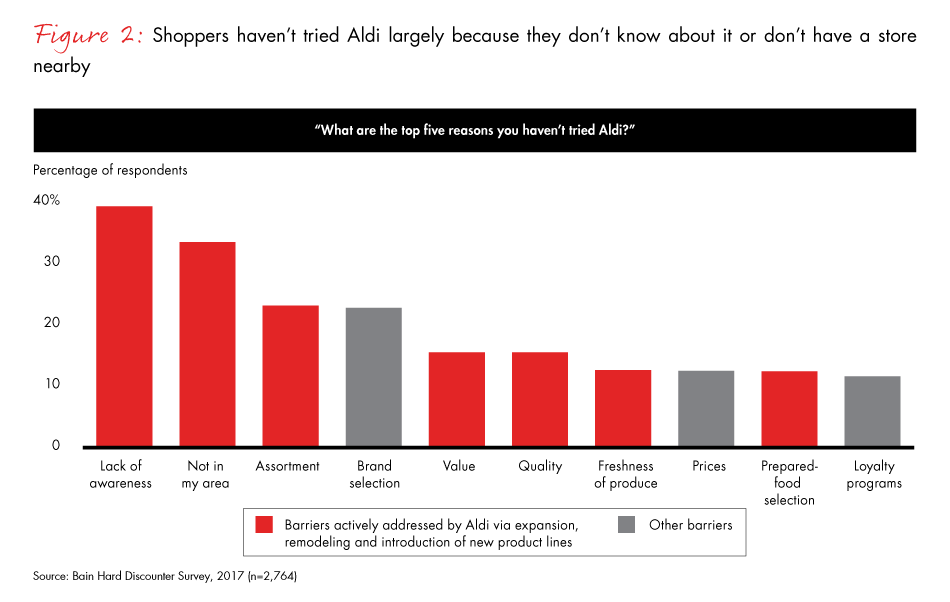
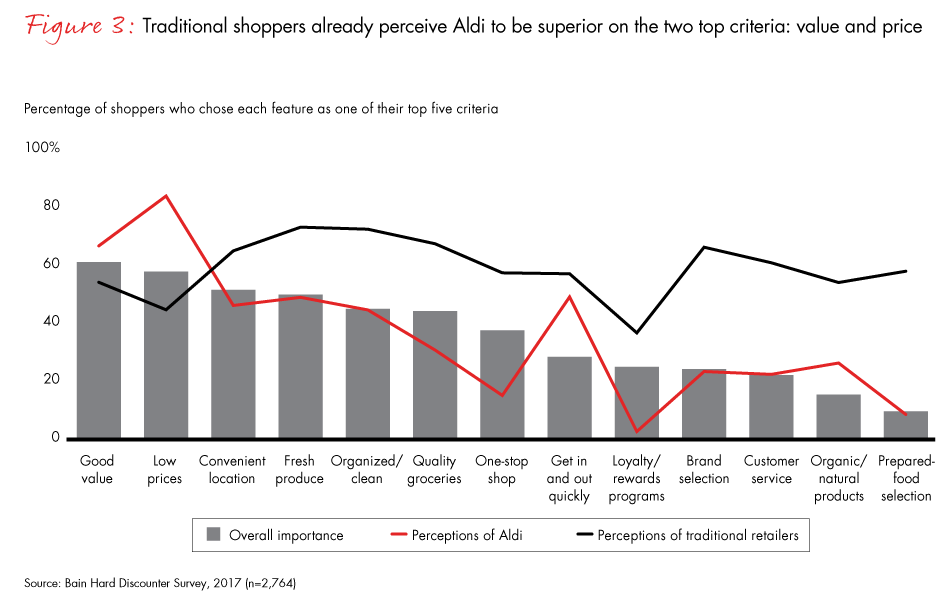
Myth: Even if they try hard discounters, my shoppers continue to strongly prefer branded goods and aren’t attracted to private labels.
Reality: On average, shoppers of all types have a favorable perception of private labels. We found that 85% of all shoppers are open to private-label products—with more than half of them saying private labels are as good as, or have even better quality than, national brands (see Figure 4). Age is more of a factor than income in private-label perception. Younger shoppers are more likely than their older counterparts to believe that private labels are equal to, or better than, national brands. However, high-income shoppers are just as likely to have that same sentiment toward private labels as low- or middle-income shoppers.
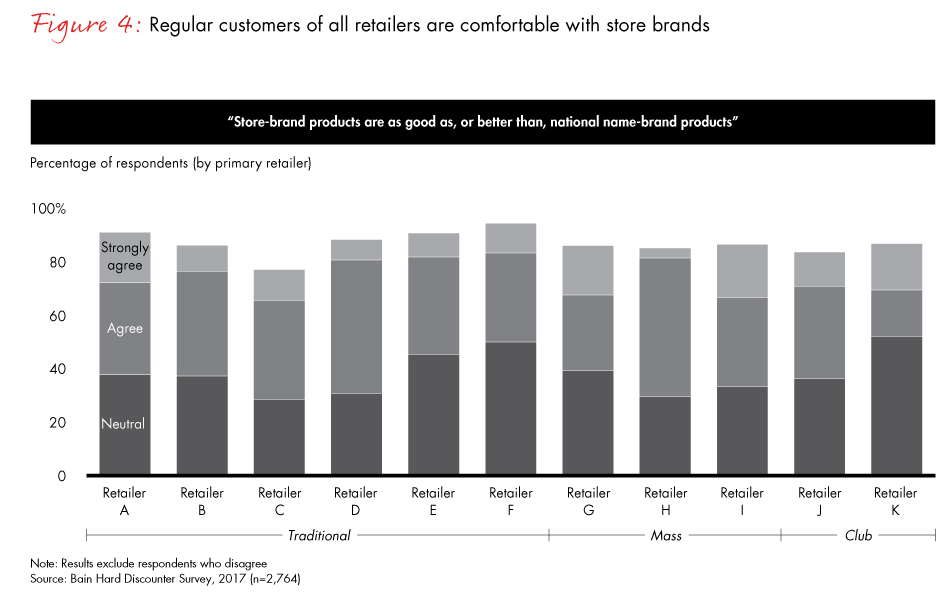
Furthermore, shoppers have a very positive perception of Aldi products specifically. Among our survey respondents, 75% of shoppers, regardless of their primary grocer, believe that Aldi’s products are as good as, or better than, national brands. This holds across almost every category, but most predominantly in milk, eggs, dairy, and canned and frozen foods (see Figure 5). Most concerning to incumbents is the fact that 69% of shoppers who have never tried an Aldi, but would consider trying it, agree or strongly agree that Aldi’s quality matches or beats national brands.
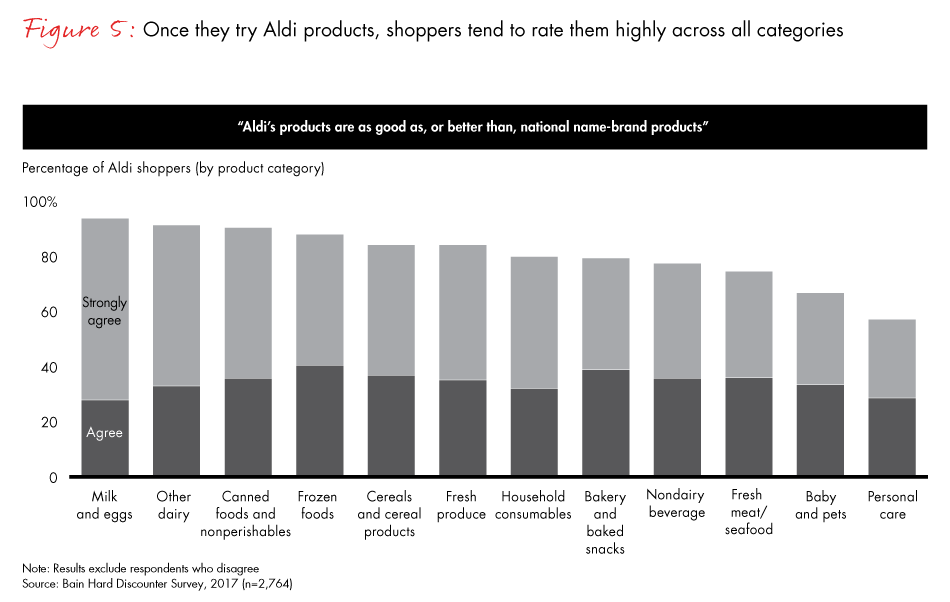
Myth: My shoppers may buy a couple of items from hard discounters. But they’ll never capture a meaningful share of my shoppers’ weekly spending.
Reality: We see a predictable pattern of behavior when shoppers try Aldi. In looking for great prices and good value, they typically start out by buying a few products in key value item (KVI) categories where price is very competitive and quality is assumed, such as milk, eggs and some canned goods. These items are a barometer of quality for the entire store, and they become the conduit to trying other categories, which are usually fresh produce, other dairy, frozen foods and cereal. If consumers start purchasing from this many categories, they are well on their way to seeing Aldi as more of a primary grocery outlet and one-stop shop. Bain’s survey data suggests that a high percentage who shop across three categories not only see the price as better, but perceive Aldi quality as on par with, or better than, national brands. The shift has a significant effect on share of wallet. Shoppers who purchase one category from Aldi spend an average of 13% of their total share of wallet at Aldi vs. 45% for shoppers who purchase three or more categories.
This scenario will get tougher for incumbents as Aldi and Lidl introduce new product lines in new categories.

Hard Discount Grocers: Myths vs. Reality
To compete with hard discounters, traditional grocers need to debunk four key myths.
Plotting your strategy to combat hard discounters
Incumbents—both traditional grocers and mass retailers—need to acknowledge the real and growing threat that hard discounters pose, then develop a clear and feasible strategy to compete.
It’s not going to be easy. Hard discounters have a significantly different business model and cost structure. Their curated assortment, lean store staffing models, supply chain principles and approach to overhead make it nearly impossible to beat them head-to-head unless you are willing to rebuild your organization from the ground up.
Hard discounters inevitably will take market share, but the key is ensuring that it comes from someone else. Indeed, winning against these discounters is about preserving as much share as possible while taking share from slower-moving incumbents.
First and foremost, price perception must be tackled. For the majority of grocery shoppers, value and price remain the most important factors in choosing a grocer. So you will need to take at least some of the oxygen out of your price gap with hard discounters, through price investment, focusing on KVIs, or targeted promotions (see the Bain Brief “Perception Beats Reality in Pricing”). Think of price as a starting point—it’s necessary, but not sufficient.
Also, remember that competing against hard discounters requires diverting funding and focus from other strategic efforts, so you’ll have to think harder than ever about the select investments that will truly differentiate your store and your customer experience.
Over the next five years, hard discounters in the US are expected to grow five times faster than traditional grocery stores. Kent Knudson, a partner with Bain's Retail practice, shares five rules that incumbent grocers can follow to successfully compete.
Five rules winners must follow
Regardless of the strategy you choose, there are five rules to follow to support your approach. We’ll look at them one by one.
Rule 1: Embrace your own private brands before your shoppers embrace someone else’s. There’s no question that private labels are here—and here to stay. As we illustrated earlier, it’s a myth that shoppers don’t want private labels. In fact, we have seen private-label sales continue to grow faster than national brand sales. Despite such evidence, some retailers reject the idea of investing in private labels. They argue that the move would just push shoppers into the arms of hard discounters. Based on our experience, we have a different view: It’s not an issue of whether or not shoppers will buy private labels, but a question of whose private labels they will buy. We urge grocers to think of these products not as private labels, but as private brands.
No longer are private-label products merely generic knock-offs. They are attractive, compelling consumer products brands. Shoppers laud the quality of Costco’s Kirkland brand products. They aren’t buying cheap spaghetti sauce; they’re buying Kirkland Signature Organic Marinara Sauce. Walmart recently opened a Culinary & Innovation Center with test kitchens to develop and demonstrate new products. They’ve launched innovative products and lines such as Street Kitchen brand meal kits, which include premeasured spices and marinades, and vacuum-sealed, frozen paleo diet meals.
Retailers getting this right are using robust private brands to convey the store’s identity, increase customer loyalty, boost category innovation, provide negotiating leverage over suppliers and raise gross margins. But most of all, they are using private brands to control the price perception of their store compared with hard discounters.
To do this effectively, retailers need distinct private-brand strategies with clear brand roles, architectures and marketing to support the price-perception message to shoppers. This is a departure from the ad hoc way that many grocers use private labels today. No longer can they be viewed just as a way to fill out the assortment at a category level. You need to be extremely thoughtful about the brand’s identity and how it links to each category specifically. For example, shoppers may buy your private-brand almonds, but would they accept your private-brand baby food or diapers?
Developing a successful private-label business means taking an approach similar to that of consumer goods companies when they create a brand strategy. As such, it requires significant management focus and consumer goods–industry capabilities—such as brand management and product development—that most retailers have not yet built.
Rule 2: Lead with fresh. Fresh produce and high-quality groceries remain two of the most important criteria for shoppers—and an area traditional retailers can still win in the perception battle against Aldi. Now, as Aldi and Lidl make investments to narrow this gap, it will be critical for incumbent grocers to preserve that differentiation both by investing in quality and boosting the perception of quality.
This means improving the sourcing and supply chain to increase initial quality, reduce the time it takes to get fresh produce on shelves, keep inventory fresh longer and cut down on waste (see the Bain Brief “Why Grocers Are Battling Big over Fresh Food”). Ahold Delhaize is partnering with forecasting firm Relex to improve fresh replenishment of its distribution centers, for example; Target has recently increased its schedule of fresh produce deliveries to its stores. Changes to in-store processes, such as optimizing stocking and restocking to minimize time on the floor and product handling, also can improve quality.
Playing to perceptions of fresh is also critical. This could mean increasing your offerings of freshly prepared meals to go. It could mean remodeling to better highlight produce and fresh categories. It could also take the form of signage and other visual cues such as having workers restock fresh food at the same time that customers are shopping or a shift in branding to emphasize fresh goods. Each of these ideas can enhance fresh perception, but they can be costly and may require trade-offs elsewhere.
Rule 3: Get more convenient while your competitors get less so. Our survey findings indicate that after good value and price, convenience is the third-most-popular reason shoppers try Aldi. That’s why incumbents need to make themselves more convenient, by expanding their presence, creating new formats or providing more convenient options in their existing stores, including investments in omnichannel.
Let’s first look at physical expansion. For grocers with a strong real estate strategy and abundant capital, building smaller stores can provide access to new shoppers in areas where larger format stores wouldn’t succeed. Success requires careful analysis of the economics of these stores and deep understanding of what will be different about their operation. The rent is often much higher, spoilage may be a bigger factor and supply chain economics may be less favorable, for example. Many incumbent retailers have launched small-format stores in densely populated areas in the past decade, with decidedly mixed results. In the US, Walmart’s Neighborhood Markets have filled in their footprint nicely. In the UK, Tesco and Sainsbury’s have thriving convenience formats, but Morrisons’ entry under the M Local banner was an expensive failure. Its convenience format failed because it was late to market, tried to expand too quickly without a proven model and, perhaps most important, had locations that were not well chosen.
Alternatively, retailers can expand through M&A. Indeed, as grocery competition increases, stronger players will have the opportunity to buy prime locations from competitors closing stores. Acquisition-driven growth may seem counterintuitive, given the prevailing belief that many retailers have overbuilt and saturated their markets. However, as hard discounters change the game, a disciplined process to evaluate opportunities for selective expansion and effectively integrate them once acquired will be a powerful weapon for winning grocers in the coming years. Selectivity is key. Be smart and disciplined about what you buy.
Real estate expansion is both expensive and often difficult, and does not address the existing footprint. So grocers must think of ways to increase convenience within their stores. Among the possibilities: better layouts, faster checkouts, improved service and omnichannel offerings. Many grocers are building click-and-collect capabilities where shoppers can purchase grocery items online and then pick them up at a store, saving shoppers valuable time. Kroger’s ClickList and Walmart’s Online Grocery Pickup are two examples. Other grocers are partnering with third-party players to offer home delivery, such as Meijer with Shipt or Safeway with Instacart.
Another word of caution. These convenience initiatives need to be tightly linked to strategy and chosen extremely thoughtfully. They must be tailored to your shoppers’ needs. The fact is, doing too many can fragment resources in a way that makes success impossible.
Rule 4: Transform your cost structure, don’t just tweak it. As hard discounters take more market share, grocers will need to rethink how they reduce costs. The idea of squeezing out a few basis points from the cost structure via a one-time cost-reduction program is unlikely to be enough. We have seen many retailers try this, only to have costs creep back in over subsequent months, requiring another “one-time” program. Only those retailers that truly transform their cost structure, often using zero-based approaches, are likely to achieve the sustained cost reductions needed to both generate investment dollars and maintain financial returns.
To be effective, zero-based budgeting requires attacking costs from the customer backwards. The key is understanding what shoppers value—and what they don’t. Often you will find certain areas are less valuable to them than you assumed. For example, many are happy to use more self-service options (if they function properly, which is not always the case). Moving to self-service models in high-cost areas like the deli or at checkout can reduce costs with very little harm to your shoppers’ experience. The possibilities are many, but it starts by understanding what they want and what differentiates you.
Other retailers use automation and digital technology to simplify processes and take costs out. For example, Kroger recently invested in technology to better monitor checkout queues as well as refrigerated and frozen cases. The new equipment is part of a broad costs program that will generate hundreds of millions of dollars to finance moves against hard discounters.
Rule 5: Use advanced analytics to unlock new sources of value. View advanced analytics as a power tool in the fight to preserve market share from hard discounters and take more of it from your weakened competitors. Applying rigorous analytics to shopper purchasing data can boost the sophistication of assortment decisions and give you negotiating leverage with suppliers. The key input is determining how shoppers truly shop categories, which is not always the way merchants have historically structured them.
Simplifying your assortment is a proven way to reduce costs and complexity, but advanced analytics allows you to do this intelligently to maintain the perception of a broad assortment—a major advantage against hard discounters. Analytics provides a view of item loyalty, substitutability and relationships within a basket, which identify opportunities to reduce SKUs while emphasizing items that shoppers really want. It also delivers precise, store-level insights, which enable merchants to present hyperlocalized assortments. Bain’s Advanced Analytics Group has seen clients reduce their assortments by 10% to 20%, while simultaneously improving category sales by 2% to 4%.
Another benefit of advanced analytics: It can greatly increase your understanding of category and supplier dynamics. Knowing when you can substitute branded and private-label items, combined with insights on supplier growth and profitability, gives you the confidence to have supplier discussions based on facts. It also helps identify win-win opportunities for you and select suppliers. We’ve seen retailers with fact-based negotiation capabilities generate cost savings of more than 5%, while spurring sales growth for both themselves and key suppliers.
Hard discounters aren’t going away. Some retailers will scratch their heads as the new competition encroaches. Others will hold their ground and grow in part by taking share from weaker incumbents. What do you need to succeed? Winners will develop a unique strategy to differentiate themselves, rethinking their approach to private labels, investing in their fresh food departments, finding new ways to define convenience, rigorously attacking costs and relying on advanced analytics to give shoppers what they want. That’s the best way to stay ahead as more and more shoppers begin their love affair with hard discounters.
Kent Knudson and Mikey Vu are partners in Bain & Company’s Chicago office and members of the firm’s Retail practice.
The authors would like to thank Jenny Song, Neha Govindraj, Christie Currie and Cody Fischer for their contributions to this work.




